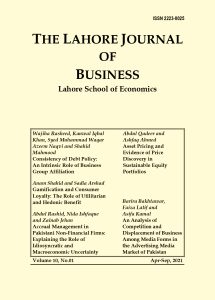When Abusive Supervision Increases Workplace Deviance: The Moderating Role of Psychological Safety and Organizational Identification
- Mamoona Arshad
- mamoona.arshad19@gmail.com (Primary Contact)
- De Montfort University, Leicester, UK (Corresponding Author)
Submitted
November 22, 2023
Accepted
November 22, 2023
Accepted
November 22, 2023
Abstract
This study offers new insights into the moderators between abusive supervision and workplace deviance. Building on the conservation-of-resources theory, the study introduces coping resources as moderators between abusive supervision and the two dimensions of workplace deviance, that is, interpersonal and organizational deviance. The study identifies psychological safety, an intrapsychic state, as a moderator between abusive supervision and interpersonal deviance. Similarly, the research tests organizational identification as a moderator between abusive supervision and organizational deviance. The study tests the hypotheses by collecting two-source of data from various Pakistani organizations. The two source data from 122 supervisor-subordinate dyads provide support for the results. The study finds that low psychological safety strengthens the positive link between abusive supervision and interpersonal deviance. Besides, a low level of identification with an organization strengthens the positive association between abusive supervision and organizational deviance. Thus, the study extends the literature by highlighting the importance of several personal and coping resources for employees at work.
Keywords
Abusive
supervision
interpersonal
deviance
organizational deviance
psychological safety
organizational identification.
This work is licensed under LJB.
- Citation
Arshad, M. (2023). When Abusive Supervision Increases Workplace Deviance: The
Moderating Role of Psychological Safety and Organizational Identification. The Lahore Journal
of Business, 11(1), 1-26.
- References
2: Arshad, M., & Malik, M. A. R. (2020). Workplace deviance: A systematic literature review and future agenda. Academy of Management Proceedings, 1, 12473.
3: Arshad, M., Malik, M. A. R., & Hussain, S. A. (2023). Silent victims: Negative effects of observing workplace deviance on employees’ emotional exhaustion and workplace thriving. Australian Journal of Management, 1-22.
4: Aryee, S., Sun, L. Y., Chen, Z. X., & Debrah, Y. A. (2007). Antecedents and outcomes of abusive supervision: Test of a trickle-down model. Journal of Applied Psychology, 92(1), 191–201.
5: Ashforth, B. E. (1997). Petty tyranny in organizations: A preliminary examination of antecedents and consequences. Canadian Journal of Administrative Sciences / Revue Canadienne Des Sciences de l’Administration, 14(2), 126–140.
6: Ashforth, B. E., & Humphrey, R. H. (1993). Emotional labor in service roles: The influence of identity. Academy of Management Review, 18(1), 88–115.
7: Ashforth, B. E., & Mael, F. (1989). Social identity theory and the organization. Academy of Management Review, 14(1), 20–39.
8: Bauer, S., Swenson, M. S., Griffa, A., Mariano, A. J., & Owens, K. (1998). Eddy-mean flow decomposition and eddy-diffusivity estimates in the tropical Pacific Ocean 1. Methodology. Journal of Geophysical Research: Oceans, 103(C13), 30855–30871.
9: Bennett, R. J., & Robinson, S. L. (2000). Development of a measure of workplace deviance. Journal of Applied Psychology, 85(3), 349–360.
10: Bhattacharjee, A., & Sarkar, A. (2022). Abusive supervision: A systematic literature review. Management Review Quarterly, 74, 1-34.
11: Cain, M. K., Zhang, Z., & Yuan, K.-H. (2016). Univariate and multivariate skewness and kurtosis for measuring nonnormality: Prevalence, influence and estimation. Behavior Research Methods, 49(5), 1716–1735.
12: Carlson, D., Ferguson, M., Hunter, E., & Whitten, D. (2012). Abusive supervision and work–family conflict: The path through emotional labor and burnout. The Leadership Quarterly, 23(5), 849-859.
13: Chi, S. C. S., & Liang, S. G. (2013). When do subordinates’ emotion-regulation strategies matter? Abusive supervision, subordinates’ emotional exhaustion, and work withdrawal. The Leadership Quarterly, 24(1), 125-137.
14: Cohen, A. (2016). Are they among us? A conceptual framework of the relationship between the dark triad personality and counterproductive work behaviors (CWBs). Human Resource Management Review, 26(1), 69–85.
15: Colbert, A. E., Mount, M. K., Harter, J. K., Witt, L. A., & Barrick, M. R. (2004). Interactive effects of personality and perceptions of the work situation on workplace deviance. Journal of Applied Psychology, 89(4), 599–609.
16: Decoster, S., Camps, J., Stouten, J., Vandevyvere, L., & Tripp, T. M. (2013). Standing by your organization: The impact of organizational identification and abusive supervision on followers’ perceived.
17: Diefendorff, J. M., & Mehta, K. (2007). The relations of motivational traits with workplace deviance. Journal of Applied Psychology, 92(4), 967–977.
18: Edmondson, A. C. (1999). Psychological safety and learning behavior in work teams. Administrative Science Quarterly, 44(2), 350–383.
19: Eisenberger, R., Lynch, P., Aselage, J., & Rohdieck, S. (2004). Who takes the most revenge? Individual differences in negative reciprocity norm endorsement. Personality and Social Psychology Bulletin, 30(6), 787–799.
20: Fornell, C., & Larcker, D. F. (1981). Evaluating structural equation models with unobservable variables and measurement error. Journal of Marketing Research, 18(1), 39–50.
Read More
